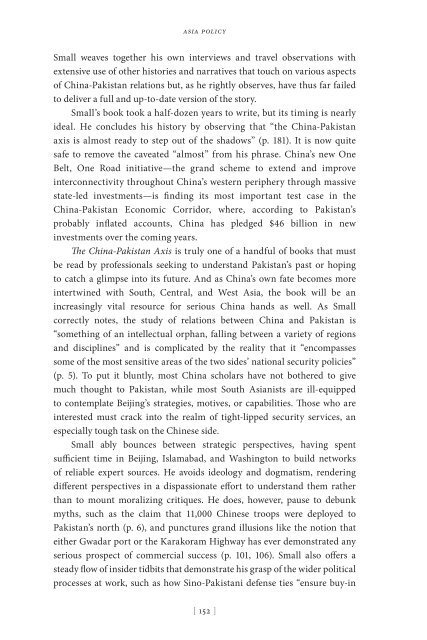You also want an ePaper? Increase the reach of your titles
YUMPU automatically turns print PDFs into web optimized ePapers that Google loves.
asia policy<br />
Small weaves together his own interviews and travel observations with<br />
extensive use of other histories and narratives that touch on various aspects<br />
of China-Pakistan relations but, as he rightly observes, have thus far failed<br />
to deliver a full and up-to-date version of the story.<br />
Small’s book took a half-dozen years to write, but its timing is nearly<br />
ideal. He concludes his history by observing that “the China-Pakistan<br />
axis is almost ready to step out of the shadows” (p. 181). It is now quite<br />
safe to remove the caveated “almost” from his phrase. China’s new One<br />
Belt, One Road initiative—the grand scheme to extend and improve<br />
interconnectivity throughout China’s western periphery through massive<br />
state-led investments—is finding its most important test case in the<br />
China-Pakistan Economic Corridor, where, according to Pakistan’s<br />
probably inflated accounts, China has pledged $46 billion in new<br />
investments over the coming years.<br />
The China-Pakistan Axis is truly one of a handful of books that must<br />
be read by professionals seeking to understand Pakistan’s past or hoping<br />
to catch a glimpse into its future. And as China’s own fate becomes more<br />
intertwined with South, Central, and West Asia, the book will be an<br />
increasingly vital resource for serious China hands as well. As Small<br />
correctly notes, the study of relations between China and Pakistan is<br />
“something of an intellectual orphan, falling between a variety of regions<br />
and disciplines” and is complicated by the reality that it “encompasses<br />
some of the most sensitive areas of the two sides’ national security policies”<br />
(p. 5). To put it bluntly, most China scholars have not bothered to give<br />
much thought to Pakistan, while most South Asianists are ill-equipped<br />
to contemplate Beijing’s strategies, motives, or capabilities. Those who are<br />
interested must crack into the realm of tight-lipped security services, an<br />
especially tough task on the Chinese side.<br />
Small ably bounces between strategic perspectives, having spent<br />
sufficient time in Beijing, Islamabad, and Washington to build networks<br />
of reliable expert sources. He avoids ideology and dogmatism, rendering<br />
different perspectives in a dispassionate effort to understand them rather<br />
than to mount moralizing critiques. He does, however, pause to debunk<br />
myths, such as the claim that 11,000 Chinese troops were deployed to<br />
Pakistan’s north (p. 6), and punctures grand illusions like the notion that<br />
either Gwadar port or the Karakoram Highway has ever demonstrated any<br />
serious prospect of commercial success (p. 101, 106). Small also offers a<br />
steady flow of insider tidbits that demonstrate his grasp of the wider political<br />
processes at work, such as how Sino-Pakistani defense ties “ensure buy-in<br />
[ 152 ]


